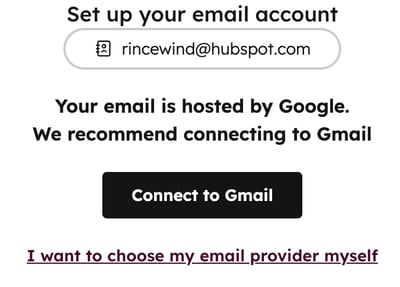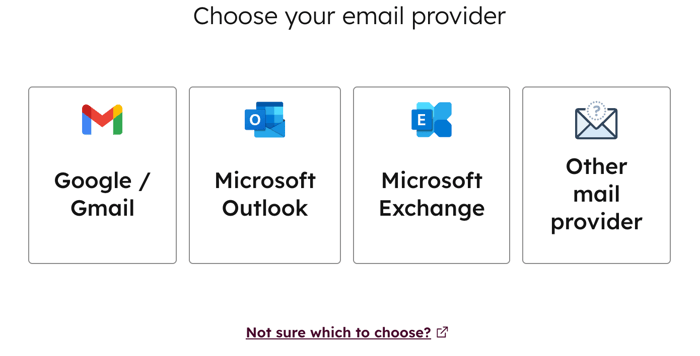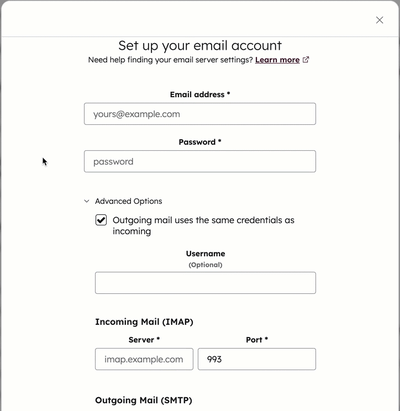- Knowledge Base
- Account & Setup
- Connected Email
- Connect your personal email
Connect your personal email
Last updated: September 18, 2025
Available with any of the following subscriptions, except where noted:
Connect a personal email account to HubSpot to send one-to-one emails from the CRM, log email replies to the CRM, send sequences emails, and install HubSpot Sales to access the sales tools in your inbox.
This email account should be unique to your user and not used by anyone else on your team. It should be the email address you typically use to send emails to your contacts, such as your company email address. By connecting your personal email account, you give HubSpot permission to send emails to your contacts using your company’s email servers. Some HubSpot tools require a personal email connection. You can connect multiple personal emails to HubSpot that your user can use to send emails.
A team email address is an email address that multiple users have access to and use to communicate with customers. You can connect a team email address to the conversations inbox or help desk so your team can view, manage, and reply to emails in one place.
Please note: users with a View-Only seat cannot connect their personal emails to HubSpot. Learn more about managing seats.
Before you get started
Below find definitions for terms relevant to the email connection process.
| Term | Definition |
| Email account/address | The email address that you use to log in to your email client and send emails to your contacts, such as your company email address (your.name@hubspot.com). |
| Email client | The application that you use to access your emails. In some cases, your email client can be the same as your email provider (i.e., Gmail is an email provider and an email client). |
| Email provider | The service, such as Gmail or Office 365, that lets you send and receive emails. |
Please note: HubSpot does not support a connection with ActiveSync, but if you use ActiveSync in your email client, connect your account using the HubSpot-Exchange connection.
Connect your email
Permissions required Personal email access is required to connect your email.
- In your HubSpot account, click the settings settings icon in the top navigation bar.
- In the left sidebar menu, navigate to General.
- Click the Email tab.
- Click Connect personal email.

- If you want to turn on inbox automation features when you connect, in the dialog box, select the Turn on inbox automation checkbox.
- Click Connect your inbox.
- In the text field, enter your email address.
-
HubSpot will attempt to recommend which email provider you should connect with. Click Connect to [recommended provider], then continue the steps below for your specific provider to finish connecting your personal email.

- If HubSpot cannot identify your email provider, select an option, then continue the steps below for your specific provider to finish connecting your personal email.

Gmail
Please note: if you connect a Gmail inbox that has an alias set up, that alias will show up automatically in the From dropdown menu in the email composer. The alias must be set up in your Gmail account before you connect your inbox.
If you have Google's Advanced Protection Program enabled in your Gmail account, you can't connect your inbox to HubSpot.
- Read through what to expect when you connect your Gmail inbox to HubSpot, then click Continue.
Necessary disclosure: when you integrate your Google account with the HubSpot platform, you can connect a number of Google services to your HubSpot account. By doing so, HubSpot will be able to access data and information from your Google account. Those services and types of data are outlined below;
Gmail: You can send and receive Gmail messages, schedule email sends, and modify email drafts in the HubSpot app. You will also be able to log and track emails sent in-app. HubSpot will have access to your Gmail data, like email headers, subject lines, and email bodies.
We'll only use your Google data to power different parts of our product that connect with the Google Workspace tools you use every day. It's your data. We just want to help you grow better. You can remove the integration in the HubSpot app by navigating to Settings > Integrations > Email Integrations and clicking 'Disable'. You can also revoke HubSpot's access from within your Google account by following the instructions listed here. For more information on the Google integration and the types of data we can access, please see our Privacy Policy.
- You'll be prompted to log in to your Gmail account. Enter the email address of the Google account you want to use. If you're already logged into one or more of your Gmail accounts, choose the account you want to connect.
- Review the required permissions, then click Allow.

- You'll be redirected back to your settings, and a dialog box will appear to inform you that your Gmail inbox is now connected to HubSpot.
Necessary disclosure: by using the Gmail email integration with HubSpot, you will grant HubSpot access to information associated with your account, including contacts, emails, calendar, distribution lists, subject lines, and URLs of tracked links from your email, if you use the email tracking functionality. In addition, HubSpot will be able to read, modify, create, and send emails from your connected Gmail account. HubSpot will scan the content of your emails to identify which emails you have elected to track in order to provide you with the notifications feature. HubSpot will store replies, outgoing mail, email headers, subject line, distribution lists, aliases, time sent, and email bodies. Your email may contain sensitive information, such as names of your contacts, your private communications, or financial or medical information. You understand that the correspondences you track will be visible to other users in your HubSpot account.
If you connect your Gmail account via IMAP (or Generic Inbox Connection), the Subscription Service will have access only to email address, password, server information, email metadata, and message bodies. Additionally, connecting your Gmail account via IMAP does not require you to connect any other G Suite applications.
Microsoft Outlook
Please note: you cannot connect Office 365 shared mailboxes to HubSpot. Office 365 GCC High and DOD environments are also not supported by HubSpot.
- Read through what to expect when you connect your Office 365 inbox to HubSpot, then click Continue.
- You'll be prompted to log in to your Office 365 account. Enter the email address of the Office 365 account you want to use. If you're already logged into one or more of your email accounts, choose the account you want to connect.
- You'll be redirected back to your settings where the connection will be verified and completed. A dialog box will appear to inform you that your Office 365 inbox is now connected to HubSpot.
Necessary disclosure: if you use the Outlook email integration with HubSpot, HubSpot will have access to information associated with your account, including contacts, emails, calendar, distribution lists, subject lines, and URLs of tracked links from your email, if you use the email tracking functionality. HubSpot will scan the content of your emails to identify which emails you have elected to track in order to provide you with the notifications tool. HubSpot will store replies, outgoing mail, email headers, subject line, distribution lists, aliases, time sent, and message bodies. Correspondences you track will be visible to other users on your HubSpot account.
Microsoft Exchange
Please note: Microsoft is deprecating Basic Authentication for Exchange Online in October 2022 and requiring Modern Authentication. HubSpot's Exchange integration uses Basic Authentication but is designed for Exchange On-Premises instances, which are not affected by this change and will continue to function with Basic Authentication after October. If you are an Exchange Online user, you can connect to HubSpot's Outlook integration instead. It is compatible with cloud-hosted Exchange and uses OAuth, a form of Modern Authentication. You can reconnect your inbox using the Outlook integration at any time.
Before connecting your Exchange inbox, confirm with your IT team that your Exchange server is running Exchange 2010 SP2 and above.
Your Exchange email address and password are required in order to connect your inbox, but depending on your Exchange server’s configuration, HubSpot may require additional information to connect. Refer to the table below before connecting your inbox to make sure you have all of the necessary information.
| Information(*required) | Example values |
| Email address* | jdoe@hubspot.com |
| Password* | HubSpot123 |
| Username | jdoe |
| Exchange URL | https://email.hubspot.com/ews/exchange.asmx |
| Exchange version | Exchange 2010 SP2 and above |
- If your email inbox uses two-factor authentication, you'll need to enter a third-party app password. Review documentation from Microsoft to learn how to generate a third-party app password.
- If you're using Exchange Online, connect your inbox to HubSpot with modern authentication using the Outlook integration. Learn more about Microsoft's deprecation of basic authentication in this HubSpot Community post.
- Read through what to expect when you connect your inbox to HubSpot, then click Continue. You can also review the HubSpot Sales privacy overview before connecting.
- In the dialog box, enter the following information:
- Email address: your Exchange email address.
-
- Password: your Exchange password.

- You can also click Show optional fields to enter your Exchange username and Exchange URL. By default, HubSpot will perform Autodiscover, which is an Exchange feature that attempts to identify the Exchange URL based on your domain's DNS. If the Autodiscover process fails, you must provide your username and Exchange URL manually:
-
- Username: enter your username. Typically, this is what is listed before the @ symbol in the email address, or your user ID.
- Exchange URL: enter the URL used to access your Exchange server.

Please note:the Exchange URL of your Exchange server will most likely be formatted as https://mail.domain.com/ews/exchange.asmx. If you're not sure what to enter, log into your Exchange mailbox from a web browser, then copy the URL and paste it into the Exchange URL field. HubSpot will be able to detect and recommend the correct Exchange URL.
- Click Connect inbox.
- Your connection will be verified and completed, and a dialog box will inform you that your Exchange inbox is now connected to HubSpot.
If you encounter an error when connecting your Exchange account, learn more about troubleshooting account connection issues.
Necessary disclosure: if you connect your email account via Exchange, HubSpot has access to your email address, password, server information, email metadata, and message bodies. These credentials give HubSpot access to other information associated with your account, such as calendar, contacts, and distribution groups.
Other mail provider (IMAP)
Before connecting your inbox via IMAP, review the technical requirements with your IT team. You must meet all of the technical requirements before you can connect. You can also review the HubSpot Sales privacy overview before connecting.
Please note: if you are trying to connect an email account to the conversations inbox, you need to connect an inbox that is hosted with either Gmail or Office 365. Conversations does not support an IMAP connection.
HubSpot does not support Amazon SES and Amazon WorkMail. If you experience issues with your connected email and use either of these email providers to host your email, HubSpot recommends switching email providers to Gmail or Office 365.
- Read through what to expect when you connect your inbox to HubSpot, then click Continue.
- Next, enter the Email address and Password used to log into your email account. In most cases, HubSpot will be able to detect your server's IMAP and SMTP settings after you enter your email address and password. Or, if an admin in your account has already configured your domain's IMAP settings, your IMAP and SMTP server information will populate automatically.
- Please note: if your email inbox uses two-factor authentication, you'll need to enter a third-party app password. Review documentation from your email provider (e.g., Yahoo Mail or iCloud) for instructions on how to generate a third-party app password. Learn more about connecting your inbox with two-factor authentication on the Community.
- If HubSpot does not detect your server's IMAP and SMTP settings, click to expand the Advanced Options.
- If your outgoing mail (SMTP) does not use the same credentials as incoming mail (IMAP), clear the Outgoing mail uses the same credentials as incoming checkbox, then enter credentials for both outgoing and incoming mail servers.
- Otherwise, enter your server's username, IMAP server and port, and SMTP server and port in the corresponding fields.
- You can also select the checkbox beside Trust any certificate if necessary. Learn how to find this server information in your email client.

- Click Connect inbox.
- Your connection will be verified and completed, and a dialog box will appear to inform you that your inbox is now connected to HubSpot.
Necessary disclosure: if you connect your email account via IMAP (or Generic Inbox Connection), HubSpot will have access only to email address, password, server information, email metadata, and message bodies. Additionally, connecting your Outlook account via IMAP does not require you to connect any other Microsoft applications.